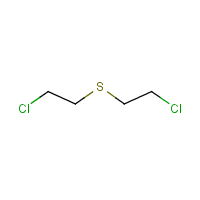Bis(2-chloroethyl)sulfide
Agent Name
Bis(2-chloroethyl)sulfide
Alternative Name
Mustard gas
CAS Number
505-60-2
Formula
C4-H8-Cl2-S
Major Category
Toxic Gases & Vapors

Synonyms
Mustard gas; 1,1'-Thiobis(2-chloroethane); 1-Chloro-2-(beta-chloroethylthio)ethane; 2,2'-Dichlorodiethyl sulfide; 2,2'-Dichlorodiethyl sulphide; 2,2'-Dichloroethyl sulfide; 2,2'-Dichloroethyl sulphide; Agent HD; Agent THD; Bis(2-chloroethyl) sulfide; Bis(2-chloroethyl)sulphide; Bis(beta-chloroethyl)sulfide; Bis(beta-chloroethyl)sulphide; Di-2-chloroethyl sulfide; Di-2-chloroethyl sulphide; Dichlorodiethyl sulfide; Diethyl sulfide, 2,2'-dichloro; Distilled mustard; Ethane, 1,1'-thiobis(2-chloro-; Gelbkreuz [Czech]; HD; Iprit; Kampstoff "lost"; Lost; Mustard HD; Mustard vapor; Mustard, sulfur; Psoriasin; S mustard; S-Lost; S-Yperite; Schwefel-lost; Senfgas; Sulfide, bis(2-chloroethyl); Sulfur mustard; Sulfur mustard gas; Sulphur mustard; Sulphur mustard gas; THD; Yellow Cross Gas; Yellow cross liquid; Yperite; beta,beta'-Dichloroethyl sulfide; beta,beta'-Dichloroethyl sulphide; beta,beta-Dichlor-ethyl-sulphide; [ChemIDplus] UN2810
Category
Chemical Weapons
Description
Oily yellow-brown liquid with garlic taste and mustard odor;
Sources/Uses
Chemical warfare;
Comments
After inhalation, it has delayed effects 2-24 hours after exposure. It penetrates the skin in 1-2 minutes without initial irritation. It is corrosive to skin and lung tissue resulting in skin blisters and hemoptysis. [NIOSH Emergency Response Card] A lethal dose is about 1.5 tsp. or enough to cover about 25% of the body surface area. Mustard is an alkylating agent that disrupts cell function by reacting with DNA and other macromolecules. The eyes, skin, and respiratory tract are most commonly affected by mustard poisoning. High doses also damage the hematopoietic, gastrointestinal, and central nervous systems. Death is usually caused by pulmonary injury, immunosuppression, and secondary infections. Most casualties recover completely after treatment of first and second degree burns. Victims who have lost vision should be reassured that it is temporary. [ccc.apgea.army.mil] Causes lachrymation; [ICSC] Thiodiglycol can be detected in the urine for about one week. Initial leukocytosis may be followed in 3-5 days by bone marrow depression. Chest x-ray may show evidence of chemical pneumonitis within a few days. [Weinstein, p. 136] 2,2'-dichlorodiethylsulfide (mustard gas) is classified by IARC as a human carcinogen, and it has a MAK skin designation. Mustard gas is fibrogenic to the lungs in the context of an acute inhalation exposure complicated by bronchiolitis obliterans.
Reference Link #1
Biomedical References
Exposure Assessment
TIH
Yes
Lethal Concentration
LCLo (human) = 23 ppm/10min
Explanatory Notes
VP depends on purity. Distilled sulfur mustard VP = 0.072 mmHg at 68 deg F. [Jane's] Exposure to vapor a significant hazard at higher temperatures, e.g., desert environment. [ccc.apgea.army.mil]
Reference Link #2
Adverse Effects
Lachrymator
Yes
Toxic Pneumonitis
Yes
Fibrogenic
Yes
Dermatotoxin
Skin burns
IARC Carcinogen
Established
NTP Carcinogen
Human carcinogen
Diseases, Processes, and Activities Linked to This Agent
Diseases
Occupational diseases associated with exposure to this agent: